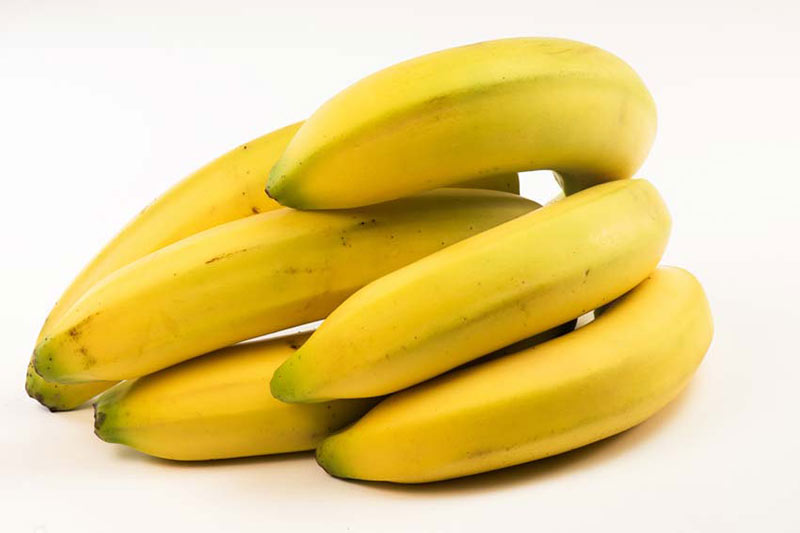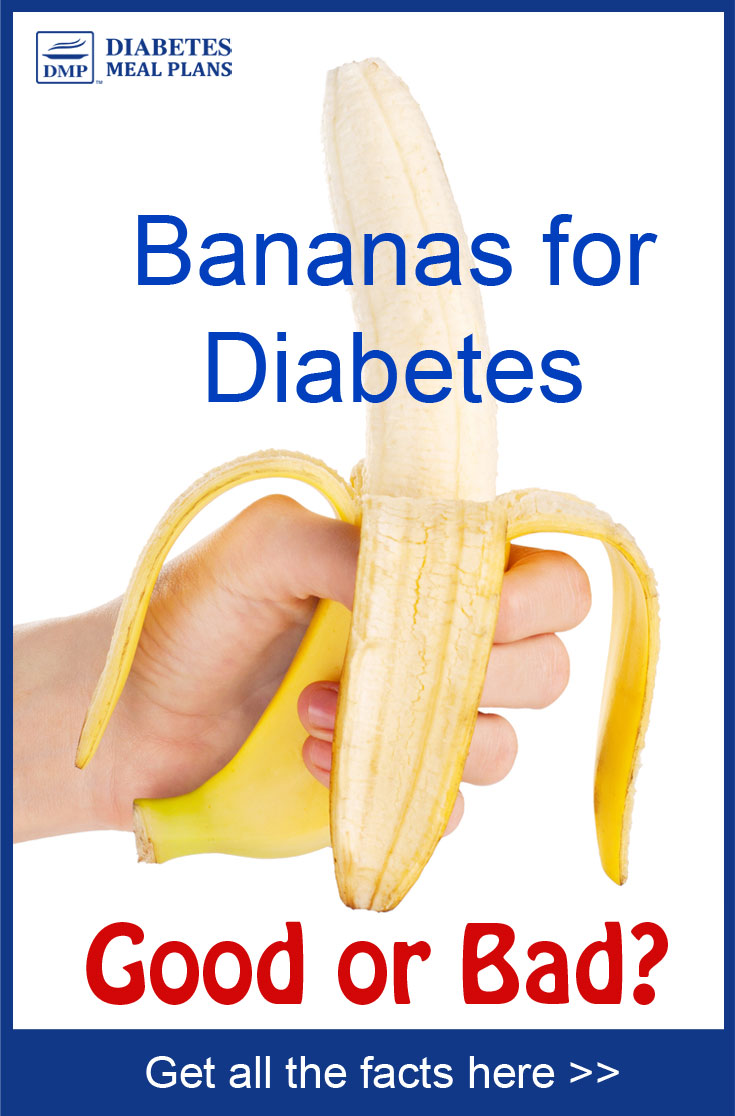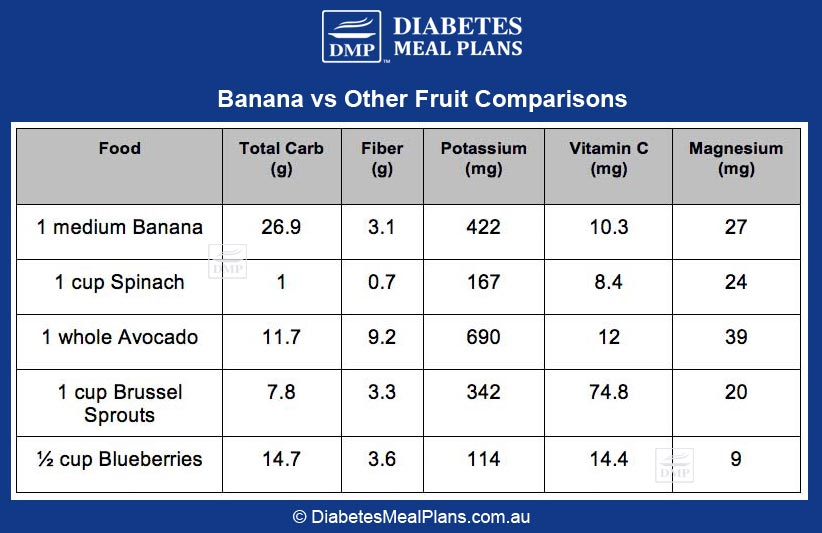Bananas for diabetes. Are you curious to know whether they are a good or bad fruit to include in your diet?
Glad you asked.
Because while eating bananas are commonly thought of as being a “healthy,” when you have type 2 diabetes or prediabetes, there’s a bit more to the story.
Let’s explore bananas together now.

Bananas: a popular common fruit
As we all know, bananas are a popular fruit, well known for their bright yellow peel and unique boomerang shape.
People from all across the world consume bananas. And as suggested above, bananas are often considered a health food because they are relatively low in calories and rich in minerals like potassium, plus they’re an easy snack to grab on the go.
Still, while they may provide various health benefits for the general population, the question still remains: are they really a healthy choice for people with type 2 diabetes and prediabetes?
To find out, let’s start by taking a peek at the nutrition facts.
Banana Nutrition Facts
For one medium-sized ripe banana:
- Calories: 105
- Total carbohydrates: 26.9g
- Protein: 1.20g
- Fat: 0.39g
- Fiber: 3.1g
With only about 1 gram of protein and less than a gram of fat, it’s pretty easy to see that the dominant macronutrient in a banana is… carbohydrates.
The carbohydrate content of one medium banana is a whopping 26.9 grams (beware of the oncoming blood sugar spikes)!
Foods with a higher carb count can sometimes be “balanced out” if they also contain a high amount of dietary fiber, which reduces the overall net carbs of a food (the available carbs for digestion). But unfortunately, bananas aren’t rich in fiber.
Just 3.1 grams of fiber is not going to make up for nearly 17 grams of carbs (all coming from simple sugars).
So, the short of it is: unfortunately, bananas won’t be making the list of diabetes friendly foods anytime soon.
As a person with type 2 diabetes or prediabetes, your main interest in any food should be whether or not it’s loaded with quick sugars and carbohydrates, as these things promote higher fluctuations in your blood sugar and A1c levels.
Right after a high carb meal you might feel sluggish, moody, and have a hard time concentrating, but that’s not the worst of it.
In the long run, a history of higher-than-normal blood sugar (indicated by an elevated A1C level or daily high blood sugar readings) can result in a higher risk for cardiovascular disease and other diabetic complications like neuropathy and vision loss – sorry for the doom and gloom but being aware of the consequences of prolonged high blood glucose is very important.
The good news is that brand new research supports a low carb diet as a great management tool for type 2 diabetes. Not to mention all the other research that supports it too – which is why we encourage a low carb diet here at DMP.
Watch Out for Fructose
Another drawback of bananas is the amount of fructose in them.
What is fructose, you ask?
Well, fructose is the simple sugar that gives fruit its sweet taste and is one of the reasons that ripe fruit is so darn appealing!
In small quantities, fructose isn’t a big problem. But snacking on fruits with medium-to-high levels of fructose throughout the day can really throw your metabolism for a loop.
A medium-sized banana contains about 7.1 grams of fructose. Compared to the major sugar-bombs like mangoes (1/2 a mango 16.2 grams) and raisins (1/4 cup 12.3 grams), bananas might seem like a pretty safe bet, but consider these facts about fructose before you make that call.
To start off, fructose has been known to disrupt the gut microbiome – gut bacteria responsible for helping to stabilize your metabolism, immune system, hormones, and overall health.
Not to mention, fructose is linked with an increased risk for metabolic syndrome, insulin resistance, and non-alcoholic fatty liver disease.
Eating a high fructose diet can also leave you feeling constantly hungry and unsatisfied, because fructose can scramble the “hunger hormones” in your body.
When the hormones ghrelin, leptin, and insulin aren’t communicating properly with the rest of your body and brain, you will feel hungry all the time and you’re more likely to reach for high carb junk food… and that’s a recipe for blood sugar disaster!
Finally, high fructose intake has been associated with greater levels of inflammation, increased oxidative stress, and even increased weight gain.
Researchers are even beginning to consider that a low fructose diet may be a potential tool for reversing insulin resistance and improving insulin sensitivity – bring on those non-starchy vegetables!
As a diabetic, what all this means is that indulging in lower carb fruit options and avoiding high fructose options (like bananas) can set you on the path toward lower inflammation, improved hormone function, more regulated blood sugar and A1c, and overall better health.
Now that we’ve set that record straight on the fructose front, let’s tackle another common question about bananas in different stages of ripening.
Please pin, tweet or share this info; then keep on reading.

Are Green Bananas Healthier Than Ripe Ones?
Green bananas often come up in conversations about fruit intake and blood sugar because green bananas contain resistant starch.
Unlike regular starchy foods (like white rice and most potatoes), resistant starch moves through the gastrointestinal track undigested.
Because resistant starch remains mostly undigested, it has a lower impact on blood sugar than other starches do.
But does that mean that diabetics can eat endless amounts of green bananas without any negative side effects?
Unfortunately, no.
Green bananas don’t automatically get a free pass just because they don’t raise your blood sugar as much as a ripe banana would.
You still have to take the total number of carbohydrates into account when deciding which foods to snack on and which ones to toss. And overall, green bananas still contain the high levels of carbs that a ripe banana does (around 26.9 grams per medium banana).
A few studies have found that banana starch may decrease glucose and insulin level after a meal. But, keep in mind that these studies often use isolated starch that is separated from the actual fruit, and therefore, does not contain any of the carbohydrates and sugars.
The key point: green or ripe, whole bananas are packed with carbohydrates and will result in an increase in blood glucose levels compared to other lower carb options.
Glycemic Index (GI)
Here’s the details on the GI of bananas:
- Unripe bananas – 35
- Ripe yellow bananas – 55
- Plantain raw – 45
- Plantain cooked – 70
Anything 55 and below is considered low glycemic index, though the lower the better. For instance, strawberries come in at just 25 on the GI scale.
However, even though bananas have a reasonable glycemic index, just be aware that there are some critical drawbacks to focusing on glycemic index alone.
Comparing Bananas to Other Potassium Sources
Another common misconception about bananas is that they are one of the top sources of vital micronutrients like magnesium, vitamin C, and especially potassium.
Being that they are a potassium-rich food, they are often recommended for blood pressure because increasing potassium intake has been shown to help reduce blood pressure levels and decrease risk of heart disease.
The truth is though, that you won’t fall short on any vitamins and minerals by skipping out on bananas.
In fact, there are plenty of other fruits and vegetables that are just as rich in potassium, vitamin C, and magnesium as bananas are. And the best part is that these alternatives are way lower in carbs!
Check out this chart that compares the nutrients of bananas versus other fresh produce.

Avocados are rich in healthy, monounsaturated fats as well as magnesium. And to top it off, they contain an amazing 690 mg of potassium! That’s more than 1.5 times the amount of potassium found in a single banana.
Best of all, avocados are a perfectly safe low carb food that will help, not harm blood sugar levels – unlike bananas.
Blueberries, Brussels sprouts, and spinach are also great sources of vitamins and minerals, and they contain far less sugar/carbs than bananas do.
Conclusion: Are Bananas a Smart Choice for Diabetics/ Prediabetics?
At the end of the day, bananas (whether they’re green or ripe) simply contain too many carbohydrates to make them part of a healthy diet for diabetes. Simply because your goal is to regulate blood sugar and A1c, so adding higher carb foods makes it more difficult to do.
Of course, you could reduce your portion sizes and eat just one-third of the banana. But as we explored above, bananas are also pretty high in fructose, the simple sugar than can shake up your metabolism in all the wrong ways.
So, if you’re craving a sweet snack, you might want to pass on the banana and reach for a low carb, high fiber fruit like raspberries.
You can also snack on a delicious protein bar or choose from one of these 40 low carb snack recipes!

excellent page on food listing for T2D.
Thanks Syed!
What if you pair it with peanut butter or some other nut or seed butter? Doesn’t the fat and protein blunt the spike?
It may blunt the spike some, but it is very likely that you will still see an unwanted rise about an hour or two later than if you ate the banana alone. (The total carbs doesn’t change, and in fact the nut butter will add about 6 or 7g.) You’re best bet is to avoid bananas, but if you absolutely must consume then consider just eating half a banana and trying to get some movement in after eating.
Thanks Emily. I didn’t realize that it would just spike later. I gave them up for the longest time a LCer then started eating them again. I have just slightly high fasting numbers so not testing right now. I’ll leave them back on the shelf. Thanks for getting back to me.
I just stumbled upon your page as I was looking for correct info on banana consumption for diabetics. I noticed that after having bananas my insulin resistance gets worse (I’m T2). Breakfast numbers go from 130mg/dL to 194mg/dL 2hours pp(same food). Good info. Bottom line avoid bananas or at least don’t eat them routinely.
Hi Shad,
Yes, bananas are a high carbohydrate fruit that I wouldn’t recommend consuming regularly for those with diabetes. You can check out the best fruits for diabetes to give you some other options!
Hmmmmm I am a chronic Diabetese type 2 and have been eating bannanas since i was a child and even today i eat at lease 3 bananas during the day and I haven/t see a change in my blood sugar as per say as i read on.. so it make me wonder though.. just saying yes am insulin dependant. In my 60’s God blessed us all xoxo
Being insulin dependent means you can compensate, perhaps more than others. By reducing carbohydrates people can reduce their insulin dosages over time, which is also good.
very correct
Great post. I wanted to add that bananas are not the healthy choice for those among us who – like me – also have kidney disease. Renal dietary guidelines for potassium intake are about ½ of what an otherwise healthy person would take in. Potassium helps the heart, but can quickly become toxic to the kidneys if insulin is not being used adequately, which is often the case with Type 1.5 (“LADA diabetes”) or Type 2 (“insulin resistance”).
Good point! If you ever need more information about the relationship between diabetes and kidney disease make sure to check out this article.
As a T2D, following a low carb diet, I don’t eat bananas. However after our evening meal tonight my wife went to eat a banana and went “yuk, it’s hard as a rock”. So I took a look in the fruit basket and, sure enough, there were a couple of very green bananas lying there. Hmmm, thought I, is it not the case that when unripe, bananas might be OK? A quick search turned up your article. So, I just want to say thanks for a very comprehensive, science based article. There’s so much junk written about nutrition and diabetes that is always nice to find a new quality source of diabetic diet info. I won’t be digesting those bananas, but I will be digesting some more of your articles :)
Thanks for that compliment Doug – glad you found the info useful.
Thanks for guideline i have learn a lot
We are always glad to help!
Why is there no list from GPs or Diabetic dietitian re what can eat+ what to avoid if T2 diabetic?? I have been eating a banana daily all my life- now learn that not good. Was advised to eat more carbs while another friend advised to cut out all carbs+ her BSugar dropped from 49 to 42! Mine is 51.
Lauren, diet recommendations vary immensely depending on who you’re talking to. Our philosophy at DMP is to use up-to-date evidence to make our recommendations- and based on the most recent research we encourage a low carb diet for those with diabetes/pre diabetes. You can find a copy of our diabetic friendly food list over here.
I am not able to comment on those blood sugar levels as you’re not reporting them in a way I am familiar seeing. Aim for a fasting blood glucose under 100 mg/dL (6 mmol/l) and under 140 mg/dL (7.8 mmol/l) 2 hours after a meal
Wat about splenda
You can find some info on Splenda here Merle.
Which fruits can i eat bcoz l love fruits so much and i am prediabetes
Find info on the best fruits to eat here Marilyn.
1). Wat do we eat if feeling unwell and av no appetite, but type 2 diabetic , has a wheat intolerance, has a sweet tooth.
2). If Avin a craving for sweet stuff, wat can we av too, if we got wheat intolerance and type 2 diabetes?
3). If out for a ‘Afternoon Tea ‘ or a ‘cream tea’ with family, wat cud we eat?
4). On food packets etc , how do we work out how many teaspoons of sugar they contain? And wat sugars listed on pkts, are the bad ones?
It wud be ideal to kno of this, please. Also great to hear that eggs are good for diabetics and they bring down the sugar levels. I adore eggs!
All great questions! Use this list as a guideline of what types of foods you should be eating on a regular basis- including all the occasions you listed in your post.
When you’re not feeling well it’s still important to eat as regularly as possible and check your blood sugar frequently as sickness can cause unusual readings. You’re best bet is to pick something to snack on from the list above, however this article goes into a bit more detail about handling sick-days.
You’re sweet tooth will be happy to know that we have many delicious dessert recipes that are low carb too! Remember, these are meant to be occasional treats. Don’t let your sweet tooth get the best of you!
One teaspoon of sugar is equal to four grams. The nutrition facts panel lists food in grams, so you will need to divide by 4 to get your teaspoons. Any form of sugar is going to adversely impact your blood sugar levels. We encourage people to use stevia or another natural alternative.
Thank you.
I am type two diabetes. I am on insulin injection.
I will take banana at moderate rate and as my snack in hypoglacemia situations.
Best regards.
Primrose
Oh my word been eating banner I am type 2 and my sugar is always been between 9 .10and 11 wish I could be advised on what to do to bring it down
Well if you’re eating bananas, cutting those out would be a great start! And if you stick to this recommended food list, you will likely see those numbers changing.